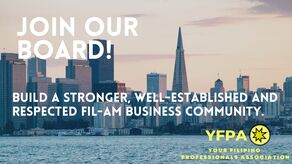 YFPA Co-Founder Greg Montemayor shares his background, thoughts on community service and accomplishments supporting the Filipino American Community in the San Francisco Bay Area. Watch the video on YouTube.
0 Comments
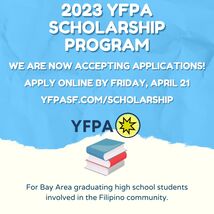 We are accepting applications for the 2023 YFPA Scholarship Program! The YFPA Scholarship Program was designed to serve Bay Area graduating high school students who are involved in the Filipino community and have been accepted into a 4 year college or university to pursue a Bachelor’s degree. Apply online today! bit.ly/3KB5a3y The deadline to apply is Friday, April 21, 2023. For more information on the program and past recipients, visit yfpasf.com/scholarship. #bayareascholarships #filamcommunity #graduatingsenior 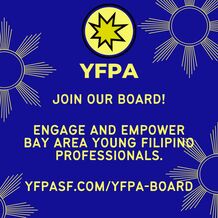 We are looking for passionate individuals to build a stronger, well-established and respected Fil-Am business community. If you are interested please fill out the Board Application form today! bit.ly/3Is7Spk For more information on YFPA open Board Member positions, please visit yfpasf.com/yfpa-board. 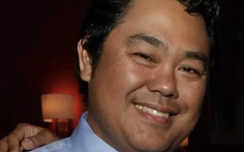 Alan Paredes our dear friend and previous YFPA Board of Directors, sadly passed on December 12, 2022 from injuries sustained from an electronic bike accident. Alan proudly served leadership positions as YFPA Marketing Director, Vice President, and Scholarship Program co-founder and Director. He was kind to all and loved supporting the Filipino community. For more information or to support, us this LINK. If you have questions, please contact Regina Finuliar, [email protected]. YFPA celebrates Asian American Pacific Islander Heritage month! We were able to interview Bay Area martial artist and instructor, Joseph Bautista, Esakbo Daan. Joseph will lead a self defense online class, hosted by YFPA and FASTER May 26!
1. How did you get started? What is the inspiration behind Eskabo Daan? My stepfather is the one who introduced me to Filipino martial arts. As I started my journey in martial arts and the age of four. I was constantly searching for an art that could feel this void that I could not explain. And I found that Filipino martial arts was that answer. I have trained a number of different arts but always felt that since there are much larger people out there and even tougher people there had to be a way to level the playing field. Since Filipino Martial Arts specializes in the use of weapons, I felt that this art is something that I can do for a lifetime. And even if I get to 80s and 90s years old and even injured that with the weapon, I will still always have a fighting chance. After all we can't rely on our youth and fitness for our entire lives. Grandmaster Robert Castro is the creator and founder of Eskabo Daan. It is a mix of different martial art styles from the Philippines. And the idea is to keep with the tradition of evolution. In order to survive everyone must be able to adapt to modern times. And that's exactly what we do. That's what the Philippine martial arts has done for the last 2,000 years to survive. Evolve and adapt. We opened in November 2009. After returning from a trip to the Philippines we were disheartened to find that even people in the Philippines were unaware of our own martial arts. To the point they were adamant Filipino Martial Arts doesn't exist. We saw martial arts schools for everything except for Filipino martial arts. We also know that many systems and Styles take from Filipino Martial Arts and don't give credit back to FMA. They simply rebrand and rename the moves and call it their own. We strive to preserve and promote Filipino Martial Arts culture, history and knowledge. 2. What makes Filipino martial arts different from other martial arts? A lot of people don't even know about martial arts from the Philippines. And the ones that do think we only can fight with two sticks. That couldn't be further from the truth. We are weapons-based system while at the same time a complete system. We kick, punch, elbow, elbow, knee, wrestle, pinch, bite, eye gouge and do joint manipulation. Not a lot of arts have that list. In Filipino martial arts we do that with and without a weapon. Law enforcement and military from around the world uses Filipino martial arts because of its versatility. So not only to be specialized in the use of weapons we specialize in versatility and adaptability. Filipino martial arts is the only art that will start you off with weapons from day one. Our mentality is if someone's going to attack you, they may be bigger than you, stronger than you, you may be injured, you may be old or there may be multiple people. So it only makes sense to try to level the playing field as quickly as possible. 3. Why do your students come to your class? They come to learn to defend themselves, learn about their culture and to be around a group of people and has like a family atmosphere. It is therapeutic to go to work out in a fun safe environment where people feel comfortable. 4. Tell us about a student that changed over time or how they benefited from your classes or workshops. We have had shy timid people on day one end up empowered and finding their voice. For both kids and adults that happens. Folks have come in with little to no self-esteem to end up with plenty of confidence. We also have folks come in with no knowledge of their own history, culture and heritage. In time they learn a lot about their Filipino roots. I personally was never proud to identify as Filipino. With FMA I am super proud of my roots and I seek to give the same for those interested in learning more about their Filipino roots. 5. Can you explain why learning self-defense is so important? Simply put your personal safety is your personal responsibility. Cops or loved ones can't always be able there to protect you. Bystanders for the most part are unwilling to step in and help should something happen to you. It is like insurance. Better to have it and not need it than to need it and not have it. Attacks can happen anywhere at anytime. It is up to you how equipped you are to handle the situation. Get more information at Eskabo Daan. YFPA celebrates Asian American Pacific Islander Heritage month! Our featured guest, Bay Area Chef Dominic Ainza cooked chicken adobo on May 20 on Zoom! Watch it here! Chef Dominic Ainza is well known in the Bay Area restaurant and the Asian American culinary scene, He has worked alongside award-winning executive chefs and developed kitchens in Michelin-recommended restaurants, such as Betelnut, Red Lantern and Attic. 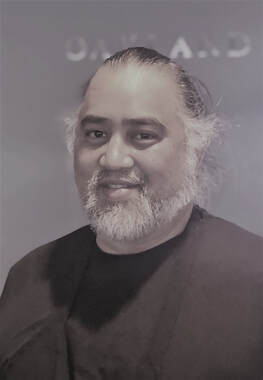 1. What inspired you to become a chef? I loved cooking. I would say I was inspired by a lot of what I was seeing on TV. But this was for me a second career. I never worked at a restaurant, and I didn’t want to start a second career earning minimum wage and working the night shift, the extra-long hours and standing all day, with minimal breaks. So, I enrolled into cooking school with the main objective of being a food tester, for like a magazine. I wanted to know how food worked. What was the difference between a good dish and a great dish, or why do you cook meat or vegetables a certain way and not all the same way? I wanted to cook a dish 30 times to know as much about the dish as possible and tell people, “this is the best version of the dish and why”. That was my plan all throughout my time in culinary school. Pretty much until my last few days of school, where I had to decide an internship. All the magazines I applied for were out of state, no pay, where I really didn’t know people. I had to decide that to stay local, I found the one restaurant that was going to pay me for my internship, or the 8 other places that were not. I ended up in a restaurant and fell in love with the whole vibe and rush and haven’t looked back since. 2. What is your favorite thing to make at home? It is not really one dish, because I can eat any version of fried rice every day. Rice and anything is pretty much comfort food. But to choose a favorite?? Cooking at times can be a little lucky, because I usually cook what I have and not so much following a recipe with the set ingredients. When something you feel that you pull out of nothing that tastes VERY good, then that becomes my favorite. It is not one dish that is my favorite, my favorite is the challenge of creating something with “nothing”. 3. Is there an item that is always in your kitchen? I will always have basic staples like onions, carrots, garlic and canned tomatoes of some type. Having these items is a good base to start with when trying to cook from nothing. Also, I have some type of frozen vegetables. I tend to think protein first when cooking a meal. So much so, then I tend to forget sides such as vegetables. Having some in the freezer is always a good got when you need last minute veg for myself and the kids. 4. What was the best cooking advice you received? The best advice that I found out myself as a failed restaurateur, is that “there is food that tastes good and there is food that sells” I tell this to all my cooks, it just goes to show sometimes you are only as good as your PR firm! More on Chef Dominic Ainza “I’m just a cook,” Chef Dominic Ainza humbly answers, but behind his humility is a focused creative passion for food and ambition to elevate cuisine that is closest to his heart. His path started in non-profit, working to help better the community as a youth counselor, developing youths to see life “a little outside the box". Chef Dominic decided to move on from non-profit and decided to go to culinary school at San Francisco's California Culinary Academy (CCA). He went to culinary school was because he "wanted to know how food works." He had never worked in a restaurant before going to culinary school, he just wanted to be a recipe tester, a great home cook and possibly go back to work with kids. Prior to opening his own and now closed restaurant, Mercury Lounge, Chef Dominic has been a force behind numerous award-winning kitchens. He worked as an intern in the kitchen of Betelnut, an award-winning Southeast Asian restaurant in the Marina in San Francisco. Working closely with Executive Chef Alex Ong and Sous Chef Daniel Sudar inspired Chef Ainza to seriously pursue his passion for the restaurant business, pan-Asian cuisine. After three years with Betelnut, Chef Ainza went on to become the opening sous chef for Poleng Lounge, a well-regarded contemporary Filipino Pan-Asian restaurant in San Francisco. Under Executive Chef Tim Lyum. Ainza also served as sous chef for Michelin Guide-recommended Red Lantern in Redwood City, CA, where he reunited with Daniel Sudar who became the executive chef responsible for this restaurant's highly acclaimed Pacific Rim cuisine. This eventually led him to return with Chef Lyum’s restaurant Attic in San Mateo. Chef Dominic’s cuisine doesn’t just represent the tradition. Just as his cultural background is a colorful quilt, his cuisine is intricately woven with the best of the Bay Area’s culinary cultures that should be enjoyed by people from all backgrounds. “Filipino food is my culture and what I love to cook. But for every dish I cook, I want to make sure I am representing history, culture, regions, integrity and families that cook the dishes. I know I did my job as a chef representing my culture.” Dominic is currently a Chef for a Bay Area tech company. 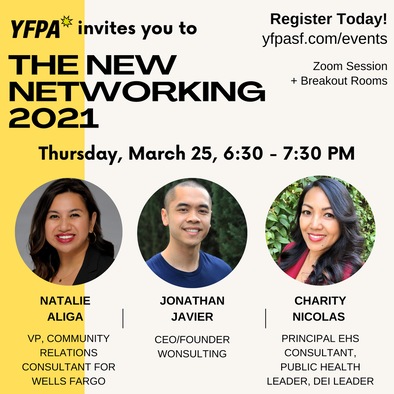 ___ Engage industry professionals. Build virtual relationships. Network with a purpose. Watch on YouTube! Virtual Presenters: Natalie Aliga Vice President Community Relations Consultant, Wells Fargo Jonathan Javier CEO and Founder, Wonsulting Charity Nicolas Principal EHS Consultant Professional networking can be challenging and working remotely may seem to make networking even more difficult. Whether working from home temporarily or permanently, you still have the ability to create meaningful relationships and build your network. All you need is a focused, achievable strategic plan. Join our virtual panel discussion and learn to become an expert networker! ___ This is a free event. If you would like to make a contribution, proceeds go to the 2021 YFPA Scholarship Program. Enter The New Networking 2021 Raffle Fundraiser! Enter today! Donations accepted for our online Raffle Fundraiser: https://bit.ly/3f8TmWh Raffle prizes: https://bit.ly/3sjdqJk ___ The New Networking 2021 Thursday, March 25 6:30 - 7:30 PM Zoom Session + Breakout Rooms YFPA Moderators: Regina Finuliar HR Business Partner, Agenus Allan Alday Deputy Director, Corporate Engagement, Year Up Bay Area Building professional relationships can be vital to finding strong mentors, discussing industry trends with peer groups, sharing skills and expertise and moving up the career ladder.
In 2021, because of Covid-19, conferences and networking events are cancelled and in-person meetings over coffee will be limited. Luckily, networking and relationship building opportunities remain available. With a little creative proactivity, you can create relevant and valuable professional connections and expand your network remotely. 1. Leverage your existing connections. You are more connected than you think! Consider your current or past mentors, advisors, roommates, friends and family, connections you made at a pre-Covid event. Begin to reach out to the closest in your network, even inside your organization, let them know your situation and what you would like to do. Start with a casual introduction and discussion, the two-way conversation will lead to productive and informative dialogue. What are they doing, what do they hear within their networks? Ask them to introduce you to contacts in their network and offer to do the same. 2. Engage on social media. Engage and network on your digital platforms. Update your information on Linkedin, Twitter and Facebook, as these platforms are designed to network. Be proactive, share links to content on industry trends, data, news articles, online events and informative webinars. When you promote your brand, use relevant keywords, photos, videos, professional experiences, online publications to support your social media presence. Take advantage of the recommendation feature on Linkedin. Reach out to industry colleagues or customers for a brief recommendation to help promote your brand. Always offer to write one in return. 3. Prepare for the meeting. Take time to prepare in advance of any meeting, whether a phone conversation or video call. Research the company and person you are scheduled to meet, even if you are in the same organization or industry. Review the company website, business segments, news and social media pages, your goal is to maximize the time with them wisely, have questions prepared and listen to their feedback. You don’t want to waste time discussing topics you could have easily researched online or have them explain the company products and services to you. In addition, it is a good idea to prepare as if you were meeting face-to-face. Avoid the casual t-shirt call from your bed. Take the extra effort when you network remotely as you would in-person. 4. Make new connections. Feel comfortable to network with people outside your industry. Network diversity offers insight into the challenges and opportunities people face in other industries, how they work with cross-functional teams and the decisions they make. Conduct informative interviews, as these are a great way to network and get a foot in the door with an organization or a person you would like to know better. Now is the perfect time. Everyone is in a similar situation. The important take away, stay active and intentional. Take advantage of the wide range of tools available to help facilitate remote engagements. Set attainable goals, for example, in three weeks connect with 10 people over email, Zoom or phone. Enjoy the time while you expand your network, as it takes time and effort, but with an organized plan you will easily promote your brand strengths and value. 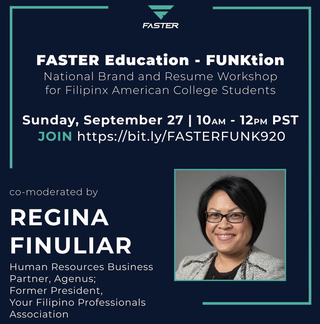 YFPA Scholarship Director, Regina Finuliar, will co-host the National Branding and Resume Workshop for Filipinx American College Students at the FASTER event, Sunday, September 27, 2020. Resumes and profiles are snapshots of experience, background and education, what employers will see first. Regina will discuss how to make your existing experience standout and help showcase your technical skills and knowledge. Register TODAY! For upcoming YFPA events and workshops visit: yfpasf.com/events 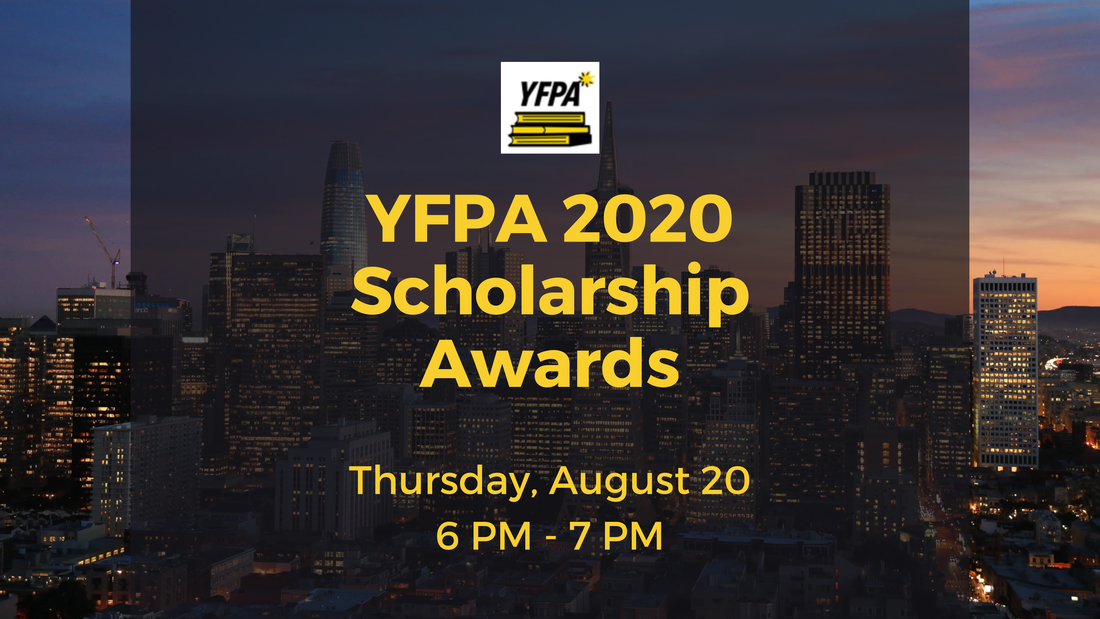 Please join us Thursday, August 20, 6:00 PM - 7:00 PM to congratulate the YFPA 2020 scholarship recipients Fausthina Dalit and Maria Paningbatan! Fausthina and Maria both plan to attend University of California at Berkeley in Fall 2020. Featured speakers Robert Uy, Attorney and past YFPA Board Member Jennifer Cabalquinto, Chief Financial Officer, Golden State Warriors Music performances by Tracy Cruz, Multi-Award Winning Music Artist and Kulintronica. YFPA 2020 Scholarship Awards Thursday, August 20, 6:00 PM - 7:00 PM WATCH THE SCHOLARSHIP PROGRAM HERE. Online Raffle Participate for a chance to win prizes from our sponsors! Purchase your raflle tickets by Thursday, August 20, 6:45 PM. Get raffle tickets HERE. Email [email protected] with questions or comments. We look forward to meeting you! Donate to the YFPA Scholarship Program! The YFPA Scholarship Program was designed to serve Bay Area graduating high school students who are involved in the Filipino community and have been accepted into a 4 year college and university to pursue a Bachelor’s degree.
|
Website by Flipcause, Inc.



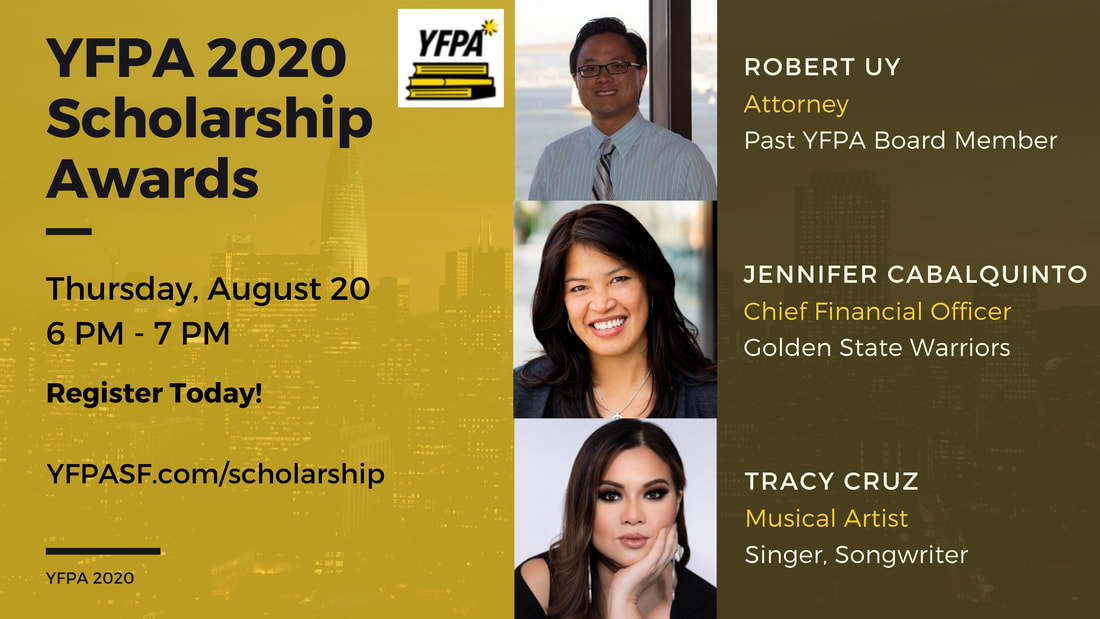
 RSS Feed
RSS Feed